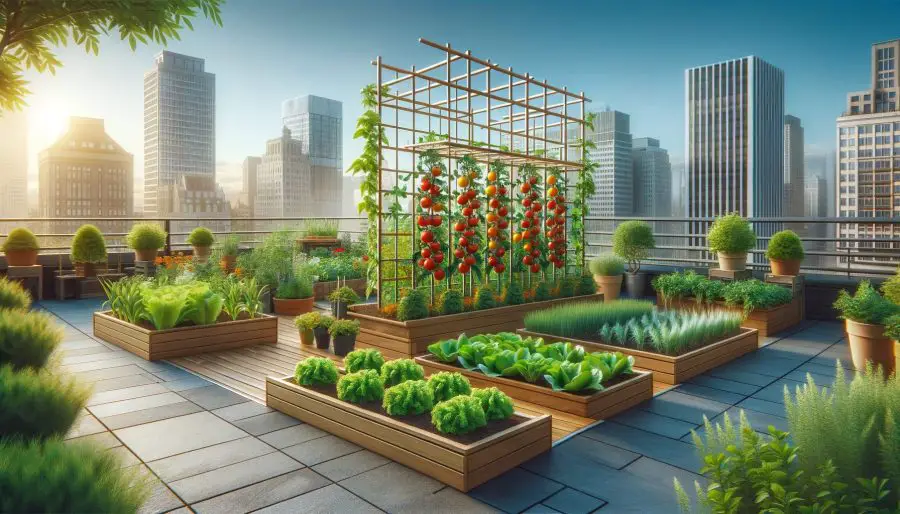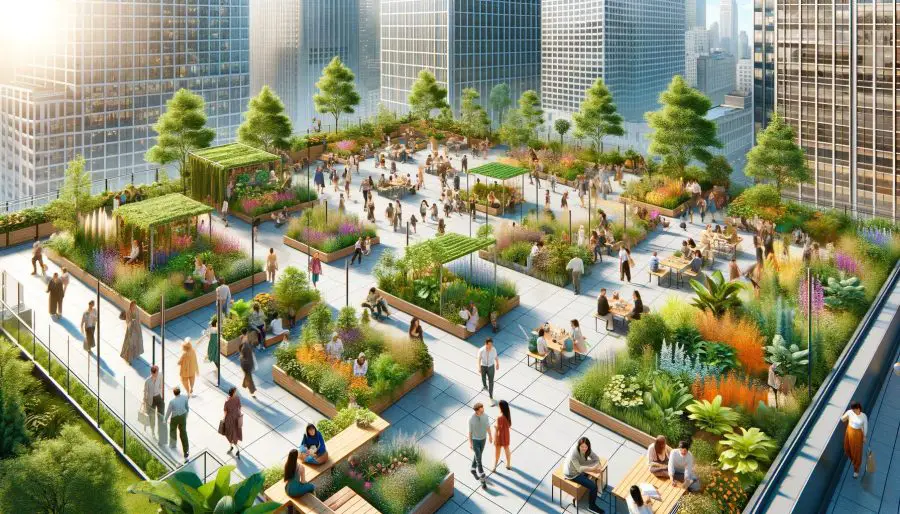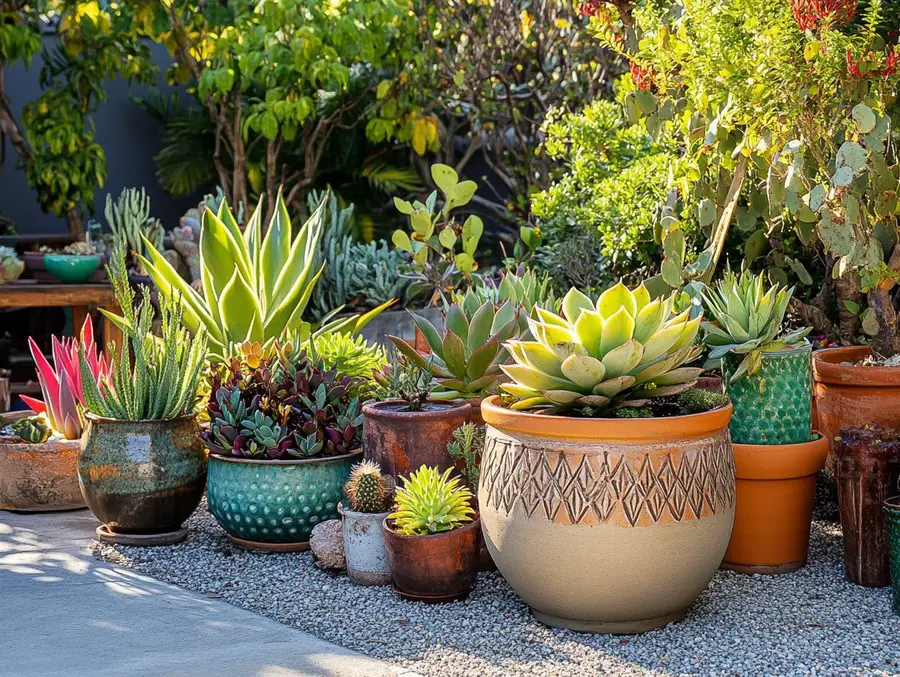We use affiliate links. If you purchase something using one of these links, we may receive compensation or commission.

Discover the benefits of rooftop gardening! Uncover how these urban oases contribute to a healthier, greener city life in a friendly, easy-to-read guide.
Rooftop Gardening Benefits
Key Takeaways:
- The benefits of rooftop gardening include reducing the urban heat island effect, improving air quality, managing stormwater, and enhancing biodiversity.
- They also create peaceful green spaces for relaxation and community engagement, while increasing property values and reducing energy costs.
Ever wondered about the benefits of rooftop gardening? Imagine transforming dull rooftops into lush, green spaces that breathe life into our concrete jungles.
This is exactly what rooftop gardening does – it’s not just about growing plants; it’s about creating healthier, happier urban environments.
Join us as we delve into this green revolution, enhancing city living one rooftop at a time.
Introduction to Rooftop Gardening

Rooftop Gardening: A Sustainable Urban Solution
In the heart of bustling cities, rooftop gardening emerges as a sustainable and innovative solution.
It transforms underutilized spaces into vibrant green areas, offering a new perspective on urban land use.
The Essence of Urban Green Spaces
Rooftop gardens are not merely decorative; they are functional ecosystems that contribute to the environmental health of urban areas.
They provide a fresh approach to urban landscaping, combining aesthetics with ecological benefits.
A roof garden is a garden on the roof of a building. Besides the decorative benefit, roof plantings may provide food, temperature control, hydrological benefits, architectural enhancement, habitats or corridors for wildlife, recreational opportunities, and in large scale it may even have ecological benefits. The practice of cultivating food on the rooftop of buildings is sometimes referred to as rooftop farming. Wikipedia
The Multifaceted Benefits of Rooftop Gardening
Environmental Impact
Rooftop gardens play a crucial role in mitigating the urban heat island effect, reducing air pollution, and enhancing biodiversity in concrete-dominated landscapes.
Enhancing Personal Well-being
Beyond their environmental advantages, these gardens offer personal well-being benefits.
They serve as tranquil retreats for city dwellers, promoting mental health and offering opportunities for physical activity.
Socio-Economic Advantages
From increasing property values to reducing energy costs, rooftop gardens have significant socio-economic impacts.
They foster community interaction and can even provide fresh produce in urban food deserts.
Aesthetic and Recreational Appeal
Rooftop gardens enhance the visual appeal of urban areas, providing spaces for recreation and relaxation.
They transform bland rooftops into attractive and inviting green spaces.
In a Nutshell: The Role of Rooftop Gardening in Modern Urbanism
Rooftop gardening stands at the intersection of nature and urban development.
It offers a sustainable approach to modern living, highlighting how even in densely populated areas, nature can thrive and bring multiple benefits to both the environment and its inhabitants.
Environmental Benefits

Introduction to Environmental Benefits
- Rooftop gardens are more than just an aesthetic addition to urban landscapes; they are a powerhouse of environmental benefits.
- These gardens, thriving above the city’s hustle and bustle, are a critical component in creating a sustainable and eco-friendly urban environment.
- They address several key environmental challenges faced by modern cities.
Reduction of Urban Heat Island Effect
- One of the most significant environmental benefits of rooftop gardens is their ability to mitigate the urban heat island effect.
- This phenomenon, common in cities, occurs when buildings, roads, and other infrastructure absorb and re-emit the sun’s heat more than natural landscapes.
- Rooftop gardens act as natural insulators.
- By absorbing heat and providing shade, they help in lowering the temperature of their immediate surroundings, thereby reducing the overall urban heat island effect in the city.
Improved Air Quality
Rooftop gardens significantly improve urban air quality. In cities where air pollution is a major concern, these gardens serve as natural air filters.
Plants in rooftop gardens absorb harmful pollutants and carbon dioxide, a key greenhouse gas, and release oxygen through the process of photosynthesis.
This natural filtration system helps in reducing the levels of pollutants in the air, making the urban environment healthier for its residents.
Natural Stormwater Management
Another crucial environmental benefit of rooftop gardens is their role in natural stormwater management.
In urban areas, where concrete and asphalt surfaces are abundant, rainwater runoff can lead to flooding and overburden sewer systems.
- Rooftop gardens absorb and retain rainwater, reducing the amount of runoff and easing the pressure on urban drainage systems.
- This absorption also helps in filtering the rainwater, reducing the amount of pollutants that end up in water bodies.
Biodiversity Enhancement
Rooftop gardens are oases of biodiversity in urban settings. They provide much-needed habitats for a variety of urban wildlife, including birds, insects, and small mammals.
- By introducing a diverse range of plant species, these gardens become a haven for pollinators like bees and butterflies, playing a vital role in the ecological balance of the city.
- The presence of such green spaces contributes to the conservation of urban biodiversity, an essential factor in sustaining healthy ecosystems in cities.
Table 1: Comparative Analysis of Environmental Benefits
| Benefit | Description | Impact |
|---|---|---|
| Urban Heat Island Effect Reduction | Absorbs heat, providing shade and cooling urban areas | Decreases overall city temperature, improving urban climate |
| Improved Air Quality | Filters pollutants and produces oxygen through photosynthesis | Enhances air quality, beneficial for respiratory health |
| Natural Stormwater Management | Absorbs and retains rainwater | Reduces urban flooding and runoff, aiding in water management |
| Biodiversity Enhancement | Provides habitats for urban wildlife | Supports ecological balance and diversity in urban areas |
In a Nutshell:
In conclusion, rooftop gardens are a vital component in the pursuit of more sustainable and environmentally friendly urban areas.
They tackle critical urban environmental issues, from reducing heat and improving air quality to managing stormwater and enhancing biodiversity.
These gardens are not just spaces of beauty; they are essential for the ecological health and sustainability of our cities.
Health and Well-being

Introduction to Health and Well-being Benefits
Rooftop gardens are not just a treat for the eyes; they are also a boon for our physical and mental health.
Amid urban chaos, these green spaces offer a unique blend of serenity and vitality.
They have become vital in promoting healthier lifestyles among city dwellers, offering a natural escape that nourishes both the body and the mind.
Mental Health Benefits
Stress Reduction and Mood Improvement:
- Rooftop gardens are natural stress-busters. Surrounded by greenery and tranquility, individuals find a peaceful retreat from the stresses of urban life.
- The act of gardening itself is therapeutic, helping to lower cortisol levels, the body’s stress hormone.
- Additionally, the serene environment of a rooftop garden can significantly improve mood, offering a sense of calm and relaxation.
Encouraging Mindfulness:
- These gardens also promote mindfulness. Engaging with plants and nature allows individuals to focus on the present moment, fostering a sense of peace and contentment.
- This mindfulness practice can lead to improved mental health outcomes, including reduced symptoms of depression and anxiety.
Physical Health Benefits
- Increased Physical Activity: Gardening is a physically engaging activity. It involves tasks like planting, weeding, and watering, which can increase physical fitness.
- This moderate level of activity is especially beneficial in urban settings where opportunities for outdoor exercise might be limited.
- Access to Fresh Produce: Rooftop gardens often include vegetable patches and herb gardens, providing fresh and nutritious produce.
- This not only promotes a healthier diet but also offers educational opportunities about food and nutrition, especially important in urban areas where access to fresh produce might be limited.
Tackling Urban Food Deserts
Improving Access to Healthy Food:
- In many urban areas, access to fresh, healthy food can be a challenge. Rooftop gardens can turn these ‘food deserts’ into food havens.
- By growing fruits and vegetables, these gardens provide residents with direct access to nutritious food options. This not only enhances their diet but also encourages a sustainable food culture within the community.
Community Involvement and Education:
- Rooftop gardens can become community projects, bringing people together to learn about and engage in sustainable food production.
- This involvement can lead to a better understanding of food systems and the importance of nutrition, fostering a community-oriented approach to health and well-being.
Table 2: Summary of Health and Well-being Advantages
| Aspect | Benefit | Impact |
|---|---|---|
| Mental Health | Reduces stress and anxiety, promotes mindfulness | Improves overall mental well-being, reduces depression and anxiety symptoms |
| Physical Health | Encourages physical activity, provides access to fresh produce | Improves physical fitness, promotes healthier eating habits |
| Urban Food Deserts | Improves access to fresh, healthy food | Enhances nutrition, supports sustainable food practices in urban areas |
In a Nutshell:
In summary, the health and well-being benefits of rooftop gardening are profound and varied.
From offering mental health relief and encouraging mindfulness to promoting physical health through activity and access to fresh produce, these gardens play a critical role in enhancing the quality of life for urban residents.
They represent a convergence of health, sustainability, and community, vital in our increasingly urbanized world.
Social and Economic Advantages

Introduction to Social and Economic Benefits
Rooftop gardens are not only green sanctuaries in urban landscapes; they also bring a wealth of social and economic advantages.
These benefits extend far beyond the boundaries of the gardens themselves, impacting property values, energy consumption, community dynamics, and even municipal policies.
Rooftop gardens are a smart investment in the present and future of urban living.
Property Value Enhancement
- Real Estate Value Increase: Rooftop gardens can significantly enhance the value of a property. They are an attractive feature for potential buyers or tenants, adding aesthetic appeal and functionality to a building.
- Studies have shown that properties with green spaces, including rooftop gardens, tend to have higher market values. The presence of a well-maintained rooftop garden can increase a property’s appeal and, consequently, its financial valuation.
- Longevity of Buildings: Beyond aesthetics, these gardens offer practical benefits that contribute to the longevity of buildings. They provide an extra layer of protection to roofing materials, reducing wear and tear from environmental elements, and thereby extending the life of the roof.
Energy Efficiency
- Natural Insulation: Rooftop gardens act as natural insulators for buildings. During summer, they help in keeping buildings cooler by absorbing heat, and in winter, they reduce heat loss.
- This natural insulation leads to a decrease in the reliance on artificial heating and cooling systems, resulting in significant energy savings.
- The reduced energy consumption not only lowers utility bills but also contributes to a smaller carbon footprint.
Community Building
- Social Interaction and Engagement: Rooftop gardens create unique spaces for community interaction and engagement. They can be designed as communal areas where residents or employees can gather, socialize, and even collaborate on gardening activities.
- This fosters a sense of community and belonging, especially important in densely populated urban environments where opportunities for such interaction might be limited.
- Educational and Recreational Opportunities: These gardens also offer educational and recreational opportunities.
- They can be used for community workshops on gardening, sustainability, and environmental awareness, further enriching the community’s knowledge and skills.
Tax Incentives
- Financial Incentives by Cities: Recognizing the array of benefits provided by green roofs, some cities have started offering property tax credit incentives for their installation.
- These incentives are designed to encourage more building owners to adopt rooftop gardening, acknowledging its positive impact on urban sustainability.
- They not only make the initial investment in rooftop gardens more affordable but also underscore the societal value placed on sustainable and eco-friendly urban development practices.
Table 3: Economic and Social Benefits Overview
| Aspect | Benefit | Impact |
|---|---|---|
| Property Value | Increases real estate value, extends building longevity | Enhances investment value, promotes sustainable building practices |
| Energy Efficiency | Reduces heating and cooling costs | Lowers energy consumption, contributes to environmental sustainability |
| Community Building | Creates social interaction spaces, fosters community engagement | Strengthens community bonds, enhances social well-being |
| Tax Incentives | Offers financial incentives for installation | Encourages adoption, underlines societal value of sustainable practices |
In a Nutshell:
In conclusion, the social and economic advantages of rooftop gardens are substantial and multifaceted.
They enhance property values, reduce energy costs, foster community spirit, and can even lead to financial incentives from municipal authorities.
Rooftop gardens are an investment in the social and economic fabric of urban communities, offering a sustainable solution for the challenges of modern urban living.
Aesthetic and Recreational Aspects
Introduction to Aesthetic and Recreational Benefits
Rooftop gardens bring a unique blend of beauty and functionality to urban environments.
Beyond their environmental and health benefits, these gardens significantly enhance the aesthetic appeal and recreational quality of urban spaces.
They transform bland, unused rooftops into vibrant, inviting areas, contributing positively to the urban landscape’s visual and experiential quality.
Aesthetic Appeal
- Enhancing Urban Landscapes: Rooftop gardens add a touch of nature’s beauty to the often stark and grey urban landscapes. They provide a splash of color, texture, and variety, breaking the monotony of concrete and steel.
- This visual enhancement can significantly improve the appeal of urban areas, making them more attractive places to live and work.
- Visual Delight and Architectural Integration: These gardens can be designed to complement the architectural style of the building, creating a harmonious blend of natural and constructed elements. The result is a visually appealing space that elevates the overall aesthetic of the urban area.
Recreational Spaces
- Relaxation and Enjoyment Areas: Rooftop gardens offer unique spaces for relaxation and enjoyment. They can be outfitted with seating areas, walking paths, and even water features, providing a serene escape from the hustle and bustle of city life.
- Hobbies and Activities: For gardening enthusiasts, rooftop gardens provide a space to engage in their hobby amidst the urban setting. These gardens can also be used for other recreational activities like yoga, reading, or simply enjoying a quiet moment in nature.
Noise Reduction
- Acting as Natural Sound Barriers: An often overlooked benefit of rooftop gardens is their ability to reduce noise pollution. The combination of soil, plants, and other garden elements acts as a natural sound barrier. This is particularly beneficial in busy urban areas, where noise pollution can be a significant issue.
- Creating Quieter Urban Spaces: By absorbing and blocking noise, rooftop gardens contribute to creating a more peaceful and quiet urban environment. This reduction in noise pollution enhances the quality of life for residents and can make urban areas more pleasant places to live.
In a Nutshell:
In summary, the aesthetic and recreational aspects of rooftop gardens are vital in enhancing the quality of life in urban areas.
They offer a visual and experiential contrast to the urban environment, providing spaces that are not only beautiful to look at but also enjoyable to use.
Rooftop gardens represent a convergence of nature and urban living, offering a unique blend of beauty, relaxation, and recreational opportunities in the heart of cities.
Benefits of Rooftop Gardening FAQs
Rooftop gardening, while offering numerous benefits, also raises many questions, especially for those new to the concept.
This section aims to address some of the most common inquiries, providing insights and practical information to help you better understand and appreciate the world of rooftop gardening.
Q: What are the challenges of setting up a rooftop garden?
A: Setting up a rooftop garden comes with a unique set of challenges.
One of the primary concerns is the cost, which can include the installation of a suitable waterproof membrane, soil, plants, and possibly structural reinforcements.
Another significant factor is the weight; the structure of the building must be able to support the added weight of soil, plants, and equipment.
Additionally, irrigation poses a challenge, as water access and drainage need to be carefully planned and executed.
Lastly, accessibility can be an issue, especially in buildings without elevators or with limited rooftop access, making the transport of materials and ongoing maintenance more difficult.
Q: How do rooftop gardens impact urban wildlife?
A: Rooftop gardens positively impact urban wildlife by providing much-needed habitats and contributing to biodiversity.
These gardens offer a sanctuary for a variety of urban fauna, including birds, bees, and butterflies, which are crucial for pollination.
By introducing a range of plant species, rooftop gardens create a miniature ecosystem that supports and nurtures different forms of wildlife.
This addition of green spaces in urban areas helps to balance the urban ecosystem, contributing to the conservation and enhancement of urban biodiversity.
Q: Can rooftop gardens significantly lower energy costs?
A: Yes, rooftop gardens can play a significant role in reducing energy costs, particularly in heating and cooling needs.
They act as natural insulators for buildings. In the summer, rooftop gardens absorb heat, reducing the need for air conditioning. In winter, they provide thermal insulation, keeping heat inside and thereby reducing heating requirements.
This natural insulation effect can lead to substantial energy savings, making buildings more energy-efficient and environmentally friendly.
These questions and answers provide a glimpse into the practicalities and impacts of rooftop gardening.
As this practice gains popularity in urban areas, understanding these aspects becomes increasingly important for sustainable urban development.
Conclusion: Embracing the Future with Rooftop Gardening
The Transformative Impact of Rooftop Gardens
Rooftop gardens have emerged as a beacon of sustainability and innovation in urban landscapes.
They address key environmental challenges and provide a multitude of benefits that enrich urban living.
Environmental and Health Benefits
These gardens combat urban heat, improve air quality, and manage stormwater effectively.
They also offer a haven for urban biodiversity. Health-wise, they provide a peaceful retreat for mental and physical well-being, amidst the urban chaos.
Social and Economic Contributions
Rooftop gardens enhance property values and reduce energy costs, marking their significance in urban economics.
They foster community spirit, turning isolated spaces into hubs of social interaction and engagement.
Aesthetic and Recreational Advantages
Beyond their functionality, rooftop gardens beautify urban landscapes, converting bland rooftops into vibrant, green sanctuaries.
They offer recreational spaces for relaxation and various activities, while also contributing to noise reduction.
Final Thoughts: A Call to Action
The adoption and support of rooftop gardening are essential steps towards sustainable urban living.
Whether you’re an individual, a city planner, or a building owner, embracing rooftop gardens is crucial.
They are not just an aspirational goal; they are a practical, impactful, and necessary addition to our cities, paving the way for a healthier, more sustainable, and livable urban future.
Related Content
Visit my Amazon Influencer Page for videos and gardening products Grow Your Own Garden





